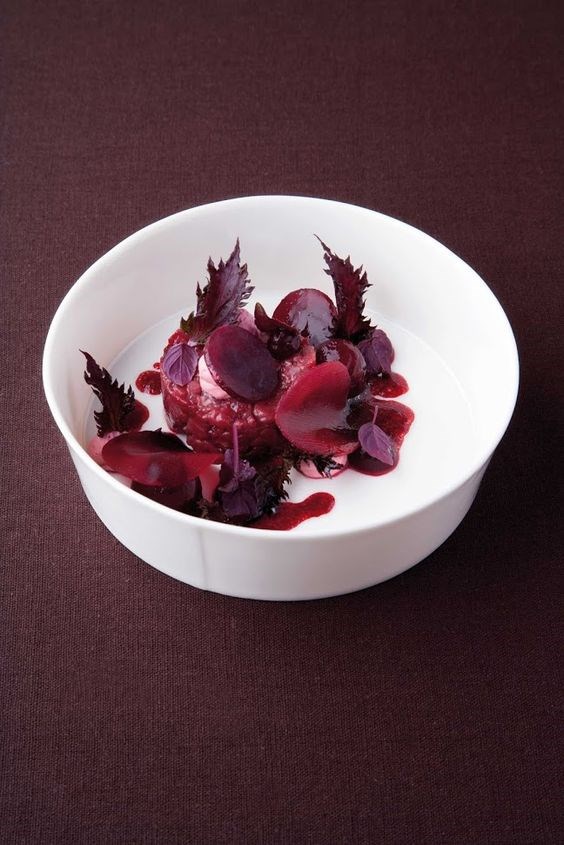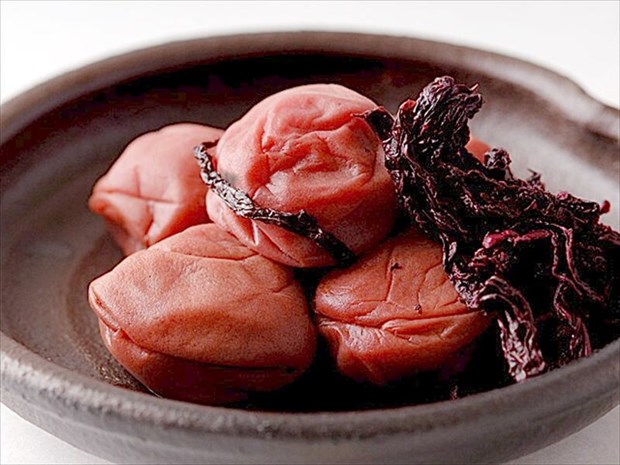What is shiso? From 'Aroma' to 'Zisuye and zisuzi,' 26 interesting facts and figures about this japanese plant: recipes, varieties and benefits.
Aroma.
Mint, basil, cinnamon, cloves, melissa, aniseed and citrus fruits: these are
the typical aromas of shiso. To enjoy them at their best, most experts
recommend using the sprouts or fresh young leaves of the plant cut into fine
strips.
Britton.
This is the name given to a bicoloured variety of perilla frutescens (see below), whose leaves are green on the upper
side and purple underneath, widely used in Korean cuisine.
Condiment.
The ume plums that are first
fermented with shiso leaves, salt and aquavit before being dried, produce a
condiment which, once reduced to powder form, is known in Japan as shiso momiji and used as a salt
substitute.
Desserts.
Many internationally renowned pastry chefs have used shiso in their sweets and
desserts: from the Smoked White Chocolate
Mousse with Meyer Lemon Granita and Shiso Ice Cream presented by Ron
Mendoza of the Sona in Los Angeles to the Kalamansi
Gelée, White Chocolate-Coconut-Soy Milk Soup, Tapioca, and Litchi-Shiso Sorbet
signed by Adrian Vasquez of the Providence, also located in Los Angeles, not to
mention the Shiso and strawberry granita,
yuzu jelly, fromage blanc foam and white chocolate cream created by Junji
Tokunaga, pastry chef and chocolatier of the Ritz Carlton in Tokyo and the
fresh tasting Shiso and mint sorbet on a
bed of creamy custard by Martín Berasategui of Lasarte's in Barcelona.
Egoma. This
is the term used in Japan for the “Japonic” variety of perilla frutescens whose seeds are also used to produce an oil. In
Korea, this particular variety goes under the name of deul-ggeh.

Dish by Tanja Grandits.
Fine dining.
Starred chefs are very familiar with the aromatic qualities of shiso. Those
like Tanja Grandits of the Stucki in Basel who presents Beef tartar with coffee oil, beetroot and shiso. Joël Robuchon, the
most starred chef of all times, in a joint venture with Air France, has created
(exclusively for passengers travelling in La
Première luxury suite class in departure from Paris Charles de Gaulle) caviar and salmon tartar with shiso
sprouts.
Gelupo.
Late in 2016 Gelupo, the renowned
London-based ice-cream makers of Soho launched seven ice-creams by seven London
chefs who had just been awarded their first Michelin star. One of the new
flavours is a yuzu and green shiso ice-cream created by Arnaud Bignon of The
Greenhouse in Mayfair.
Hojiso.
Shiso flower buds often used as a garnish for sashimi: the flowers should be
picked up with chopsticks and dipped in soy sauce.
Italy.
The Japanese city of Toyama, capital of the eponymous prefecture in the Chūbu
region, has launched a project called Global
Perilla Network with the aim of promoting shiso sales in Italy. Cristina
Bowerman of the Glass restaurant in Rome, who is bridging the gap between the
two cultures, has been asked to use the herb in a traditional Italian dish. The
result is her Artichokes of long life
which features both the leaves and oil of shiso (also known as egoma).
Jyuunin.
The ancient Japanese name for shiso. It literally means "ten years":
tradition would have it, in fact, that its health-giving properties lengthen
life expectancy by one decade.
Kaz Iimori.
The executive chef of the Blue Ribbon
Sushi in New York is among those who swear by using the fresh leaves of
shiso as a “receptacle” for the wasabi condiment of sashimi. Whether fresh or
preserved, he also recommends the use of this herb with vegetables, teamed up
with noodles and in sushi rolls, especially in the ume shiso roll.
Liquor.
In Japan, Choya Umeshu liqueur is a
popular drink: low in alcohol (15%), it marries umi plums with shiso leaves.
However, the US-based Sidetrack Distillery
has marketed a Shiso Liquor, which is
much more alcoholic (45%), strongly characterized by the pronounced grassy and
spicy notes of this herb.

Shiso Mojito.
Mixology.
White rum or cachaça (plus the juice and zest of yuzu, lime and ginger ale) served
with shiso leaves instead of mint offer a mojito-style
"divertissement". Another version is vodka, brown sugar, yuzu and
shiso; or tequila, shiso and cucumber; or even gin, shiso, cucumber, lemon
juice and gum syrup as prepared by the Nobu
(London), where this cocktail is known as Cucumber
& Shiso Martini. In other words, mixology has discovered the Asian herb
and is putting it to good use!
Nutritional values. Iron, calcium, phosphorus, potassium, vitamins A, C
and B2 have determined the crowning of shiso as the "exotic
superfood" of 2016.
Oil.
Extracted from the roasted seeds of the plant, its oil is rich in alpha
linolenic acid and the fatty acids Omega-3 and 6. It has a characteristic nutty
flavour and is widely used in Korean cuisine for preparing fried foods or
vegetable stir-fries and for giving an extra kick to sauces, as well as being
the (once secret) ingredient of perilla leaf and vanilla ice-cream with salted
caramel created by the starred-establishment Soigné located in Seoul.
Perilla frutescens. This is the scientific name of the plant which,
despite having a structure similar to that of basil, belongs to the mint
family. As well as the aforementioned Britton
and japonica varieties, crispa reigns
supreme in Japanese cuisine; its leaves may either be green (with a pronounced
aroma of cinnamon) or red (tending towards aniseed with a less spicy taste).
This plant, or rather, a derivative of an aldehyde extracted from the plant
itself, is a powerful sweetener called perillartine
which is, would you believe, 2000 times sweeter than sucrose.
Qi.
In traditional Chinese medicine stands for vital energy. According to this
ancient oriental practice, the leaves and seeds of perilla frutescens have the power to rebalance the qi.
Remedy. Apparently,
when the leaves – of the red variety in particular – are rubbed on the skin,
they act as a remarkable mosquito repellent: the insects seem to be discouraged
by this highly aromatic fragrance.
Seeds.
As well as being used to produce oil, the roasted seeds are a typical
ingredient of Korean cuisine in which they add nutty and spicy notes. When
ground to a flour-like consistency, it becomes deulkkae-garu which is added to soups and stews to give them a
thicker, creamy texture. In Nepal and some areas of neighbouring India, the
seeds are roasted, ground and mixed with salt, chilli pepper and tomatoes to
make a sauce.
Traditional recipes. In Japanese cuisine, the leaves appear in tempura,
they strongly characterise umeboshi (see below) and team up with pickled
ginger, they are used to wrap little meat or fish patties, they are ideal
accompaniments for sushi and sashimi and also end up in the mixture of tsukune (chicken meatballs) or in shiba-zuke, the Kyoto speciality made
from aubergines, cucumbers, red shiso leaves, ginger and myoga (a milder-tasting "cousin" of ginger). In Korean
cuisine, where the fresh herb is called kkaenip, it is added to kimchi, the traditional dish of pickled
vegetables and spices. In Vietnam, on the other hand, it gives an added kick to
salads, fish dishes and soups, while in Laos it pops up in khao poon, the
traditional soup containing chicken, fish or pork with fish sauce, garlic,
shallots, Lao chilli pepper, galangal, lime leaves and perilla.

Umeboshi.
Umeboshi.
The red-leaved variety is an essential ingredient of umeboshi, the well known Japanese condiment containing plums to
which it confers pungent notes and a characteristic red colour. One of the many
recipes in which it is used is Ume Shiso
Maki, also known as sushi with umeboshi paste, shiso leaves, alga nori,
rice and, not uncommonly, cucumbers.
Vocabulary.
Apart from the Japanese word shiso used throughout this article, perilla is
also called tía tô in Vietnam, zǐsū in China, deulkkae or tŭlkkae in
Korea, "pak maengda" in
Laos, silem in Nepal and India and wild coleus (North America). Then we
have synonyms such as "beefsteak plant" owing to the fact that the
leaves of the red variety would seem to resemble steaks, or
"rattlesnake" owing to the sound produced by the seeds in their pods.
It is also widely referred to as Chinese or Japanese basil, Japanese thyme,
purple mint, wild basil and perilla mint.
Wok. In
Chinese cooking, its fresh leaves are tossed in the wok with garlic or ginger
and served as a side dish.
Xiang Su San.
This is the name of the herbal tea mentioned in the Imperial Grace Formulary of the Tai Ping era, dating back to 1107
A.D., in which the dried leaves are reduced to a powder and mixed with tiger
nut tuber (or chufa), dried citrus
peel and liquorice. This would seem to be a remedy for the common cold and
digestive disorders.
Yukari furikake. This is a Japanese term referring to the dried ground
leaves of red shiso: with the addition of salt, sugar and malic acid, this
mixture is used to flavour rice and soups.
Zisuye and zisuzi. Deriving from zĭsū,
in which "zĭ" stands for
the purple colour of the stalk and sū for the beneficial effects of the brew
made from it, the two Chinese words respectively indicate the leaves (ye) and the seeds (zi) of the perilla frutescens.
By FDL